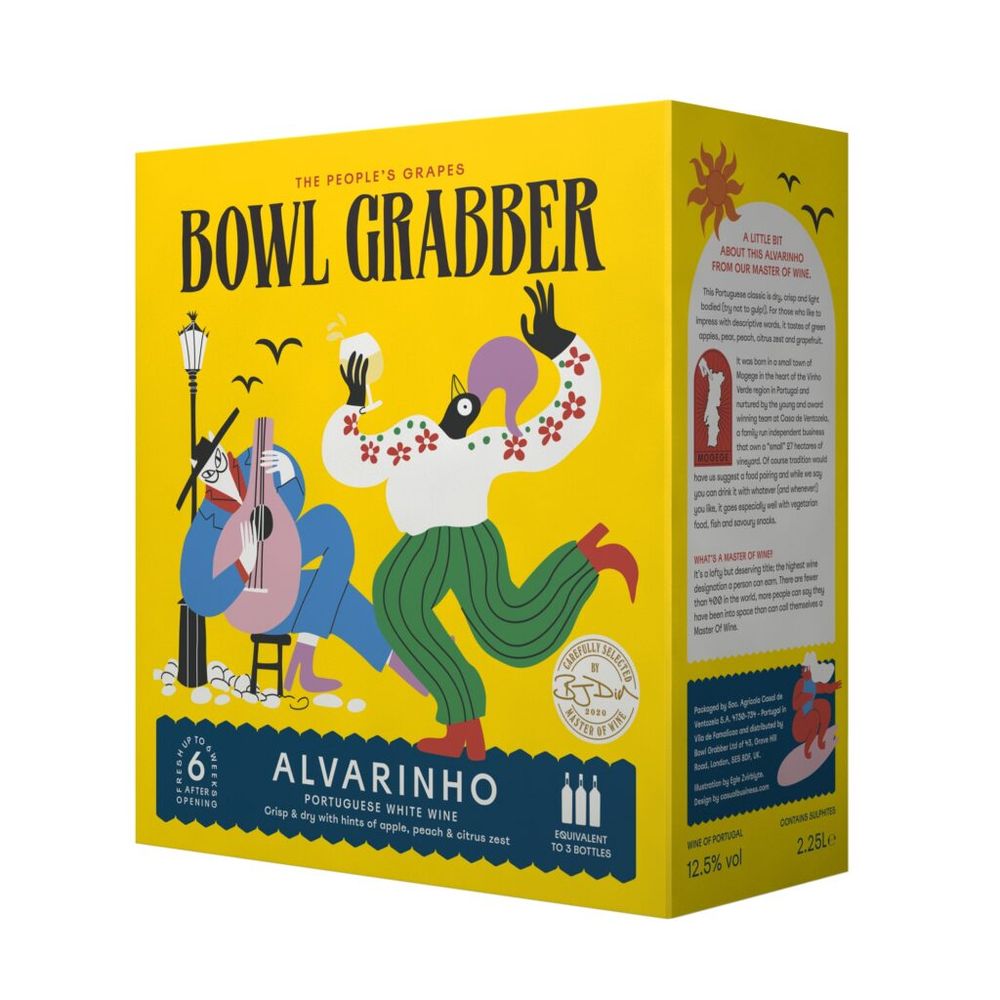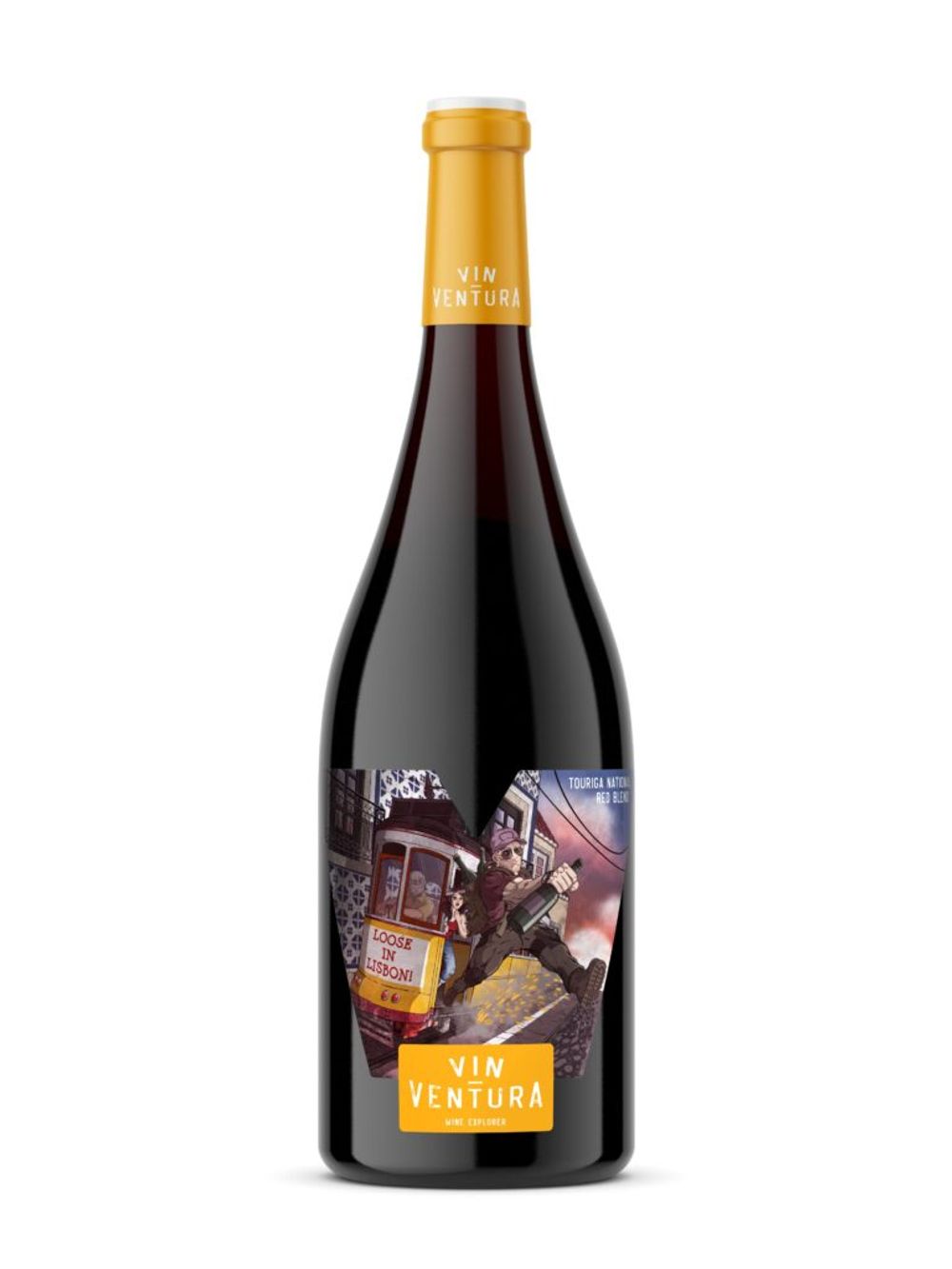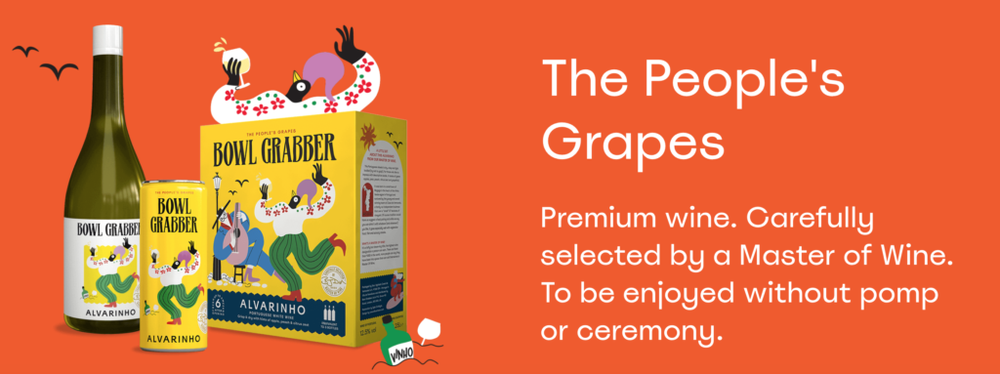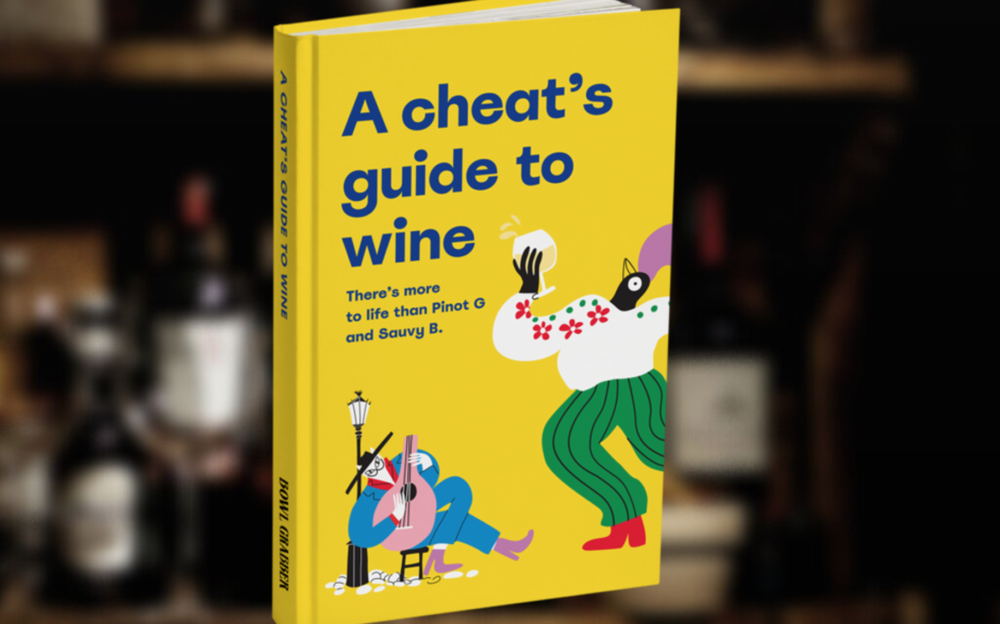Both Bowl Grabber and Vin Ventura hope to appeal to a younger wine drinker. One that is looking for a wine brand that represents them; with an attitude and purpose more than worrying too much about how it is made.
“I have to be honest, I knew absolutely nothing about wine before doing this,” is how Nick Palmer introduces himself and why he is so keen to talk about a brand he has created, rather than try to push and promote brands he is paid to think up creative ideas for.
For in his day job Palmer heads up creative product development at MediaCom one of the worlds biggest communication agencies with the likes of AB Inbev, LVMH, Tesco, Coca Cola, eBay and adidas on its books.

Nick Palmer hopes to bring his experience of working with major FMCG brands to make a difference with his new Bowl Grabber wine brand
He says the inspiration for wanting to get into wine at all came more out of frustration than a burning desire to unleash his creative talents on an unsuspecting wine world. He was frustrated that he could not get a straight forward, easy to understand quality wine that he could just have a glass of on a Sunday afternoon and then not have to throw the rest of the bottle away a few days later.
Yes, his way into wine came through a fascination with bag-in-box wine and the chance to create a wine brand that was made specifically to work well in a box, rather than as an add on to your already successful bottled wine.
He says a friend of his had been raving about the quality of a boxed wine he had got from the restaurant group, St John’s. So he went out and bought one and his mind started racing.
Here was a wine, as a new parent, he could enjoy a glass or two of and then come back to a few days later and not be worried it had gone off. But he always aware of the social stigma involved in drinking wine out of a box – it’s not the kind of thing you would take to a dinner party isn’t it?
“It got me thinking. Why don’t you make the box part of the brand?”
Wine expertise

Barry Dick MW has many years experience blending and making wines for major brand owners such as Accolade and now has the chance to do it for himself
But he still had the issue of not knowing anything about wine. So it was time to find someone who did. Enter Barry Dick MW, and all his years of experience making major branded wine for Accolade Wines and own label brands for supermarkets.
“I simply gave him a call and we quickly realised that we agreed on so many things, particularly around making wine so much more accessible and easy to understand for consumers. He told me about the wine projects he had on the go and we thought why not work together,” says Palmer.
So they had their team. Palmer with all his creative brand experience and Dick with his winemaking skills and knowledge of the wine industry.
Dick says he was immediately attracted to the idea of working with Palmer as so often he has been involved in wine projects in the past where the issue of actually developing a brand is not always the most important factor.
Palmer thinks being a complete newcomer to wine has actually been a benefit in that he is not held back by traditions and the rights and wrongs of what has been done in the sector before. “I believe a bit of naivety can take you a long way. You are not weighed down by conventions,” he says.
All about brand activation

Pinder and Dick have worked hard to get a design that truly reflects the fun, irreverent personality of the brand
The skill in creating a brand is not just the initial idea about what the brand does and where it fits into the market, but how you then activate it, sell it and communicate about it to your potential target audiences.
“If we go back 15 years compare to now then work at Mediacom was relatively simply. It was the time before proper digital, when Facebook was just for students,” he says. “Since then the world has changed completely from a marketing and communications a point of view.”
Even within digital marketing there are those who throw around the buzz words and the right terminology, and those who actually know how it works, he adds. “It’s very different to be an actual practitioner and knowing how to make it work.”
Just in the short period of time he has been working in wine, Palmer is aware of all the chatter there is about “creating brands in this space” and the desire to make a brand for a particular type of consumer. “But there is very little about the art and science of actually creating doing it,” he stresses.
Too often still in business, marketing and branding is seen as the “fluffy stuff” but that ignores the “real science” that goes into making marketing work and how to do it properly.
Easy to remember, easy to buy

Dick and Pinder will be hoping consumers will be grabbing cans of Bowl Grabber when we move into warmer weather
He points to brand expert, Byron Sharp, and says all brand and marketing work needs to be driven by two core fundamental principles: “Be easy to remember and easy to buy.”
“If you apply those principles to wine, there are very few brands that are easy to remember andeasy to buy,” he adds.
Which brings us to the principles behind its own Bowl Grabber brand.
Palmer explains: “I wanted to create a memorable brand that stuck two fingers up to the conventions of wine society. Younger people find that a barrier – the stuffy side of wine. So with Bowl Grabber we start with a brand that is about doing something that is not usually accepted in wine circles. Grabbing a wine glass by its bowl, rather than by the stem.”
That’s the concept that that he took to Dick. “It really was a meeting of minds,” says Dick. Palmer had already looked closely at the market and “was being driven by consumer insights and not about the family heritage” of a particular winery or region, he says.
“I really bought into that idea of being easy to remember and easy to buy.”
He had also been working on his own brand ideas for a while, but what he really lacked was what what Palmer could provide. And vice versa.
Launching Vin Ventura

Barry Dick MW has used his experience in making brands for major players such as Accolade to create his own Vin Ventura brand
Dick had initially looked to launch a brand called Wine Super Hero which was all about an Indiana Jones type winemaker character who travelled the world seeking out lost treasures of wine.
The idea had caught on and he had supermarkets interested in listing it (agreed a listing for x 6 wines at a Major Multiple), but his idea was quashed by a legal complaint from DC Comics. A valuable lesson learnt. A brand idea is only a good one if it is legally sound as well.
The Wine Super Hero brand has now been refined and evolved into Vin Ventura, that still keeps the idea of an exploring winemaker seeking out unique wines, but in wine terms is down to earth and focused more on appealing to those consumers – particularly younger ones – who are seeking out authentic products with a purpose. Or as its brand messaging claims: “A growing thirst for unearthing hidden wine gems from around the globe.”
Different but the same

Palmer says that on the face of it Bowl Grabber and Vin Ventura are “two very different brands” they both share the same principle and desire to shake the wine category up and offer new consumers brands they can relate to and are relevant to their lives.
The reason Bowl Grabber works so well as a boxed wine is because it is a brand that encapsulates being relaxed, sitting back, putting your feet up and just picking up a glass of wine – bowl and all.
“It’s why the format is so important,” says Palmer. As well as bag-in-box they are also introducing it in cans and in formats you can enjoy when out and about or easily at a party.
Palmer was also able to call in some favours from his contacts book and has worked with a designer who usually helps pull together campaigns for the likes of adidas, Google and Smirnoffto come up with the distinctive Bowl Grabber look and feel.
“It fits in with the brand. Everything about it is supposed to be distinctive and easy to remember,” he adds.
It is being launched in both bottle and bag-in-formats, with cans to follow in the spring. Bottles retailing down from £9.99 a bottle and £27.99 for a 2.25 litre bag-in-box.
Within a few weeks it has already secured listings with Ocado for three of its SKU starting with the 75cl bottle, 2.25l bag in box and 250ml slim can of Portuguese white Alvarinho, with more SKUs to hopefully follow in the spring.
Wine and adventure
Vin Ventura’s brand purpose is “more adventurous” it’s “more cerebral,” claims Dick. “It’s about wine exploration and bringing a sense of adventure into wine. That’s what we hope comes across in the visuals.”
He has looked to capture this attitude using an alter ego, wine exploring character called “Vin Ventura” as his ‘nom de plume’ that appears on the back label.
That will be crucial to the brand’s success, says Palmer. A wine brand that is centred around a person really helps make a “strong connection” with your audience, he adds. Which in this case is firmly driven at millennials. “It will really work in digital as well. Having a poster boy for the brand if you like.”
But put Bowl Grabber and Vin Ventura on a retailer’s shelf and you still have the same target audience.
“Same consumer, but with different drinking motivations,” explains Palmer.
Interestingly he points to what has happened in the natural wine sector, and how it has attracted so many younger consumers, as being a key lesson for the wider wine industry.
Yes, it is about discovering and supporting independent winemakers with a purpose, but it also very much taps into the consumer’s desire to be “casual”. To get away the traditional ways of doing things.

Mock-up created for smartymockups.com
Cutting through
Consumers, he adds, are also interested in style and simplicity and brands that cut through, he adds. Look at the success of the Portuguese wine brand,Porta 6, or I Heart. It’s about wine styles and an attitude or lifestyle approach to branding, rather than what chateau it came from.
“How does a consumer navigate themselves from simple varietal wines, through to really complex wines? It’s really hard to bridge that gap.”
The other big issue is language and the fact the average consumer simply does not understand every day wine terminology. “It’s a huge barrier,” says Palmer.
It’s why Vin Ventura will look to solve some these issues for consumers around knowing how to remember or pronounce a particular wine variety or region, by giving each wine a nickname, or a memorable illustration, “V” label shape, and the fact it has been created by ‘BJ Dick’ on the back label.
So with Vin Ventura it is less about the actual plots of land the wine comes from, but the fact the person who has found it and helped make it has got 20 plus years experience of travelling the world seeking out the best wines.
Dick adds: “Vin Ventura aims to find the wine place where the worlds of up and coming wine styles and regions, quality and value, interesting stories of a new varietal discovery or winemaking techniques all collide in order to make a perfect fit with the Vin Ventra brand attitude and proposition. Vin Ventura has the potential to bring a number of these like-minded wines together in a concise range presented to like minded consumers.”
It means Vin Ventura, in time, can really dig into some off the beaten track wines and varieties, he adds. A brand that he believes can really make a name for itself at £9.99 on shelf.

Bowl Grabber is also targeting DTC with its brands and a range of lifestyle goods
Making brands work digitally
We can expect to see that personality be carried through its digital marketing, with videos and social media feeds.
They also don’t have the budget that a MediaCom digital marketing team would have, and Palmer recognises the cost of acquiring just one customer via digital is expensive.
“There are lots of tools you can use with digital marketing, so we are going to have to be careful which ones we go with first to help create and capture demand.”
The opportunity they have, especially with Palmer’s background, is in out thinking competition in digital marketing. “The bar for digital marketing for wine brands is relatively low say Palmer.
“Just a quick look at Google Analytics and Keyword Planner will tell you that.”
There are terms such as “best canned wine” or “best bag in box” that they can use a bit of their digital skills to ensure that over time they are at the top of Google ranking – for as Palmer says 80% of clicks go to those first three rankings.
They will take advantage of this by creating carefully written blogs, and content that tap directly into the top search terms. Over time they want to be top ranking for those areas they identify as most valuable; in Google and YouTube search.

Palmer explains: “The goal is to clearly get as many of these people online clicking and going to our website and then building up a subscriber database so we can build a better understanding of our customer base to give Bowl Grabbers what they want and when they want it.”
It’s why Dick has written an ebook – A Cheat’s Guide to Wine – that covers all these key search terms, offering answers and suggestions – their data first approach to serving up relevant information to their customers is what they hope will set them apart from traditional operators in this space.
Initially the brands are being targeted at the multiples and grocery channels, but Dick also sees good opportunities for them in the casual dining sector, and premium burger bars.
Then there is the direct to consumer opportunity and both brands are being offered online as well.
Again the issue is how much do you invest in customer acquisition and working around that. Hence the role of eBooks and other cross marketing activity and competitions to generate leads and sales.
It is also, like with all the FMCG brands, going direct a great way to really understand you consumer base and what it is about the brands they really engage with or not, says Palmer.
Part of that engagement will be promoting the work it plans to do with the Wateraid charity to emphasise the environmental and sustainable principles of the two brands; something Palmer believes is becoming table stakes with younger consumers. Palmer says “there are not many opportunities in your life to tackle real issues in a meaningful way and our idea of “turning wine into water” felt like the perfect fit for our brand and the ongoing movement of the circular economy.
2020 may have been a stop, start year, but it has also given time for the two to come together and really work through their strategy and trading opportunities for the two brands. 2021 will be about making that happen.








































